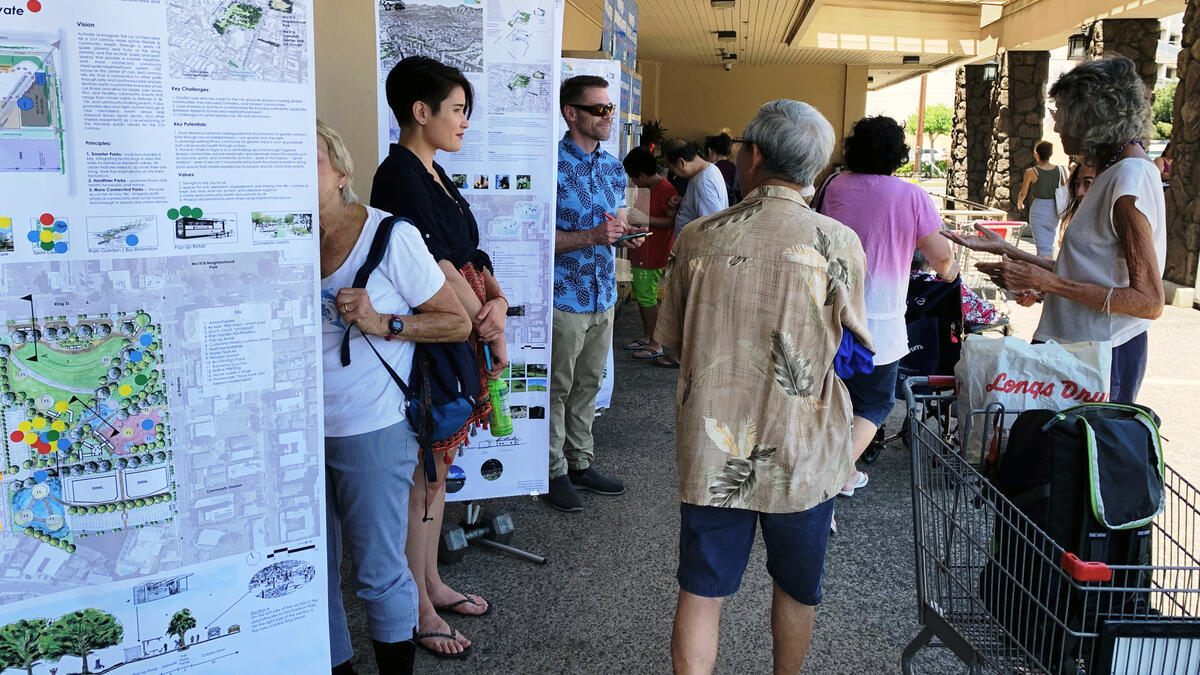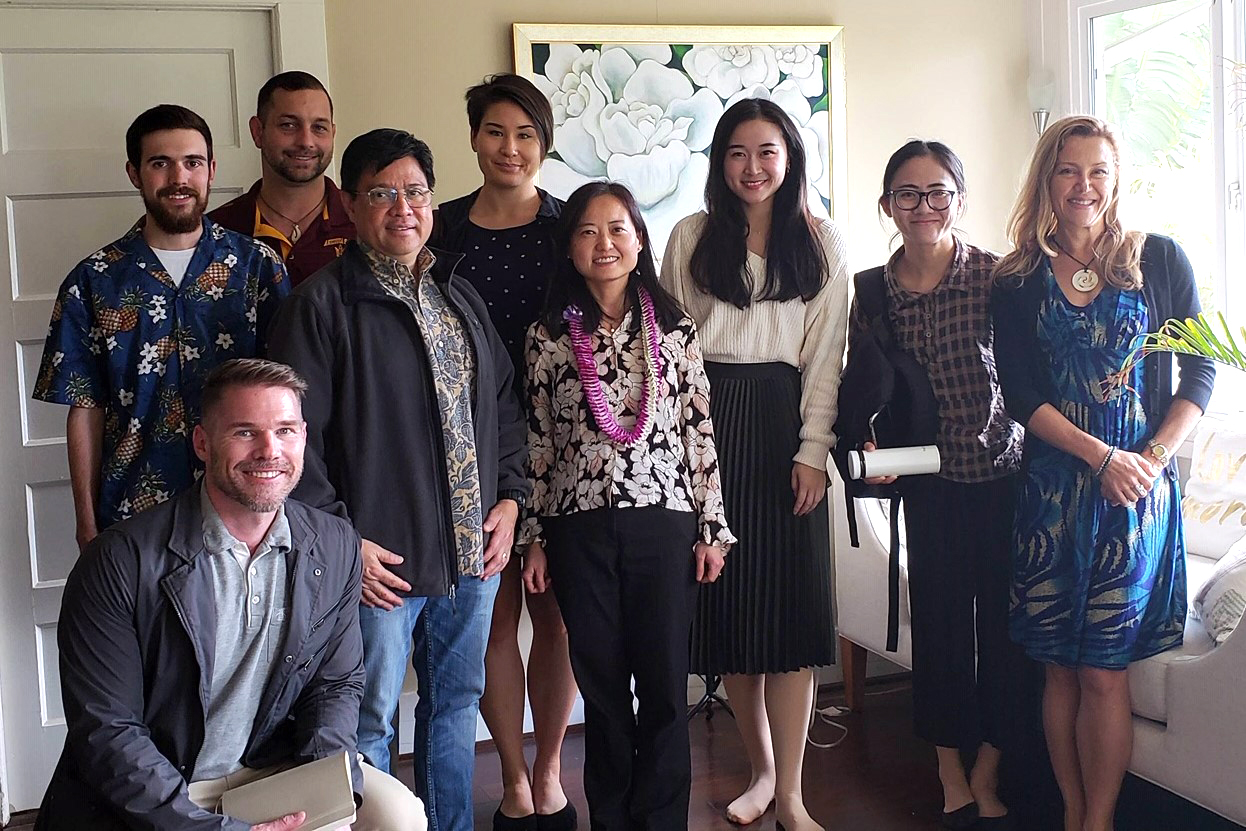Designing for community and sustainability

ASU students shared three park redesign concepts with the community through pop-up presentations at various locations around the Mōʻiliʻili neighborhood, including a grocery store. Photo courtesy of Ren Andres
It’s a common story: Developers start transforming public spaces with little to no input from the community — and it doesn’t end happily. But, as Arizona State University Assistant Professors Paul Coseo and Chingwen Cheng (both in The Design School, part of the Herberger Institute for Design and the Arts) have demonstrated, there are inclusive approaches to community design. For the 2018–2019 academic year, they led a group of four landscape architecture students and one design student in a project to collaboratively redesign Old Stadium Park in Hawaii.
The team was invited to collaborate on this project because of longstanding relationships between The Design School and Hawaii initially built through the University of Hawaii’s “Make the Ala Wai Awesome” competition in 2017. Another ASU team, led by senior sustainability scientists Coseo, Cheng and Darren Petrucci (also a professor in The Design School), won first prize out of 40 submissions to this international competition seeking design solutions to challenges facing the Ala Wai Watershed.
In partnership with the Blue Zones Project, the Ala Wai Watershed Collaboration, Hawai’i Green Growth and the University of Hawaii at Manoa, the 2018–2019 team visited Honolulu three times over two semesters — experiences made possible with funding from ASU LightWorks.
The purpose of the first visit in November 2018 was to meet local leaders and teachers while learning about the area’s culture and nature, including the Ala Wai Watershed in which the park is embedded. Before this visit, the students studied participatory planning theory and methods, conducted a workshop to redesign an open space on an ASU campus and engaged in other experiences to prepare them to work in a real community.
Upon their return to Arizona, the team made maps of the existing Old Stadium Park and surrounding Mōʻiliʻili neighborhood so that residents could visualize their neighborhood in a different way — something to “hang their ideas on,” Coseo said. In February, they traveled again to Honolulu to host a community design workshop.
The team was initially met with scepticism from the community because they were outsiders — and some residents had been hurt by previous design projects that did not consider the community’s needs.
“Some people questioned what we were doing and why we were there,” said Ren Andres, one of the Master of Landscape Architecture students involved with the project. “In the beginning I was thinking the same, even though we were invited there. However, after establishing trust with local stakeholders, the process began unfolding beautifully and we ended up having a really positive and enriching experience, both as designers and as human beings.”
Coseo and Cheng said they made clear that their team’s goals were to facilitate the conversation process and then translate the residents’ ideas into spatial reality so that the city could be set up for success when implementing a new design.
“We really framed it around, this is their park, this is their process, these are their ideas,” Coseo said. “We knew that for this to be a healing process, it had to include all voices: angry voices, voices that were excited, voices that were hurt by previous processes.”
The ASU team poses with Pono Shim, president and CEO of the Oahu Economic Development Board (fourth from left), and Amanda Ellis, executive director of Hawaii and Asia Pacific for the ASU Julie Ann Wrigley Global Institute of Sustainability (far right).
Sustainable design concepts
Between the second and third visit, the team grouped comments about what residents said they wanted into different themes and created three visual concepts: Activate (promotes physical fitness and community engagement), Discovery and Adventure (includes a new dog park, community garden and wetland system), and Urban Forest Reserve (preserves open space and native vegetation while promoting relaxation).
The team was careful to incorporate into all designs indigenous stewardship of watersheds and green infrastructure to address flood mitigation, water quality and biodiversity of the Ala Wai Watershed so the neighborhood is livable and resilient for years to come. The park, Cheng said, is a demonstration project to show how sustainable community design benefits both the residents and the environment.
One example of a sustainable design element they included is a stormwater biofiltration system (consisting of wetland vegetation, bioswales, modular filtration cells underneath pickleball courts and a detention pond) that can channel and cleanse stormwater from the streets and mitigate flooding.
They shared the three concepts with the community through pop-up presentations at various locations around the Mōʻiliʻili neighborhood — outside a shaved ice shop, for instance — during their April visit, and talked to 150 residents over two days.
Learning by doing
In the end, the ASU team delivered two products: a design tool kit that residents could use to further the process themselves, with support from the Blue Zones Project and Hawai’i Green Growth; and the three conceptual designs for the park that the city of Honolulu and the Blue Zones Project could use to continue the conversations with local residents. Eventually, the city will hire consultants to price out redesign options and understand maintenance involved.
Andres said that through this process, she learned that people want to be heard, that community engagement requires building trust, and that it’s vital to set aside the ego and go into a project with the intention to serve the community.
“As individuals, we all have our own particular set of experiences and biases about the built environment and how communities ‘should’ be,” she said. “Working in a drastically different culture and environment, I became very aware of those biases in myself. I believe that is a very important piece of self-awareness to have and keep in the design field.”
Fellow project partner Yumeng Xie, who is pursuing a PhD in design, environment and the arts, said that working as outside designers gave them an opportunity to learn how to work with a community different than their own. “Sometimes these differences may bring challenges, but (they) also could give us more inspiration and innovation,” she said. “It is important for designers to learn how to deal with something new.”
Coseo and Cheng added that it’s valuable for ASU students to venture afield, learn lessons out of the classroom and bring them back to Arizona.
“Many students end up staying and practicing in the state, so it’s important for them to get out and experience different paradigms,” Coseo said. In particular, Coseo said that Hawaii is a rich place to learn from because of its cultural diversity and its indigenous concepts of sustainability that go back thousands of years.
As long as there is a meaningful exchange of knowledge and ideas between ASU students and Hawaiian residents, Coseo and Cheng said they hope collaborations like these can continue.
“The success of this cross-sector collaboration with The Design School represents an ideal model for partnerships necessary to tackle society’s biggest challenges and cultivate the next generation of leaders,” said Colby Takeda, the Blue Zones Project community program manager for the Mānoa-Makiki-McCully-Mō'ili'ili neighborhood. “The ASU team’s innovative approach to community co-design, attention to historical and cultural context, and creative and technical competencies led to powerful designs that will drive real community change and inspire our entire state to reimagine public spaces as hubs to promote the health of our people and the environment.”
More Environment and sustainability

ASU prof turns trash into treasure
The Research Corporation for Science Advancement, or RCSA, regularly hosts a series of discussions known as Scialog, a…

Best outdoor experiences are shared and build connections, recreation professor says
Steve Sassaman doesn’t really need to tell you he’s an outdoorsman. One look at his full, dark beard gives a vibe that clearly…

ASU offers new project-based courses for global leaders of tomorrow
Addressing complex challenges requires innovative solutions.This is why the College of Global Futures — with its four academic…
